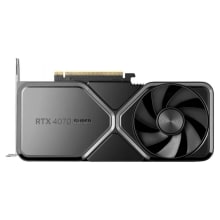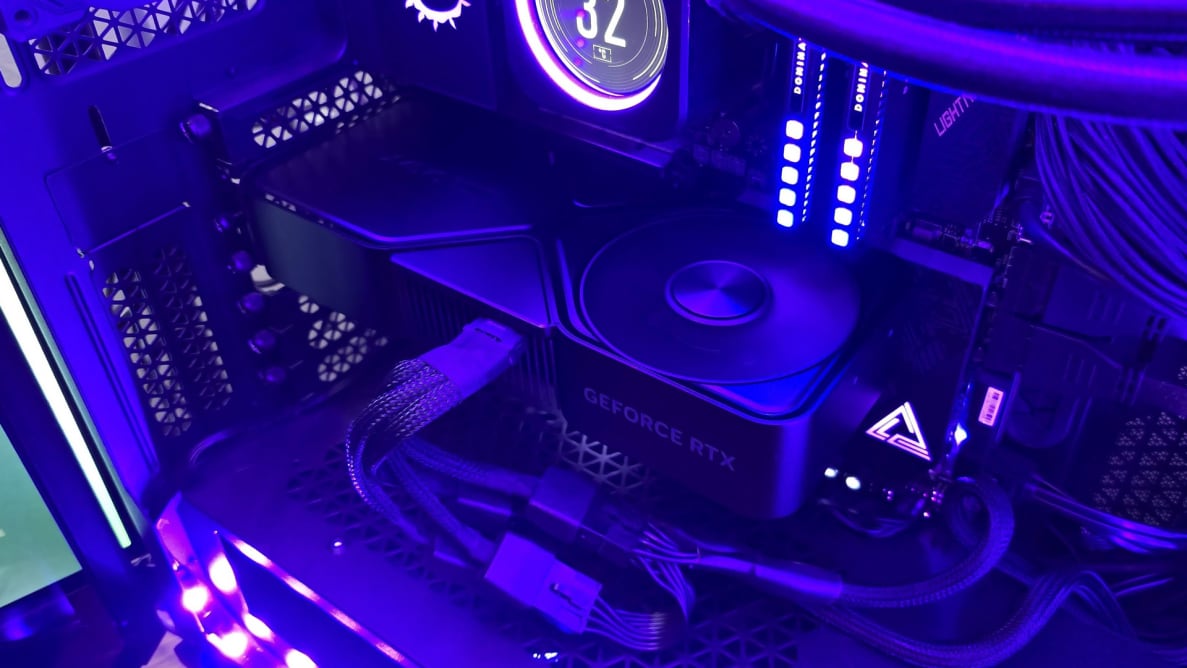Pros
-
Great performance at 1440p
-
Competitive pricing for ray-traced gaming
-
Good temperature and noise levels
Cons
-
Only 12GB of VRAM
-
Requires Nvidia’s proprietary connector
About the Nvidia RTX 4070 Super

The Super refreshes are physically the same as their predecessors except for a new all-black color scheme.
The RTX 4070 Super is a mid-cycle refresh designed to offer moderately better performance at the same price as the original RTX 4070, which itself has been given a $50 price cut. We tested Nvidia’s Founders Edition model and the prices of cards from third-party manufacturers will adjust up or down based on the model, availability, and competitiveness. The Gigabyte Gaming OC, for example, is currently available for $650 while the ZOTAC Twin Edge OC has been on sale for as low as $580.
The upgrade over the original RTX 4070 is mainly in CUDA core count, which has been increased to 7168 cores versus the 5888 on the original. Clock speeds are nearly identical with the Core Clock measuring only 60 MHz faster at 1.98 GHz. It’s a small bump, but since Nvidia’s GPUs intelligently ramp up clock speeds based on temperatures (which the 4070 Super doesn’t struggle with), the card should exceed this when gaming, which makes it pretty negligible.
The rest of the design remains the same. It features matching display connectivity, the same 12-pin power connector, and the same dual fan design with a blow-through heatsink. The dimensions are also unchanged. The only physical modification comes from the new blacked-out design that does away with the silver accents of the original.
We tested the RTX 4070 Super across a battery of synthetic and real-world benchmarks. Since ray tracing performance is one of the key reasons you would choose an Nvidia card, we recorded results with RTX enabled as well as rasterized-only. The system used for testing utilized an AMD Ryzen 9 7950X3D CPU running in an X670E MSI MEG ACE motherboard, 32GB of Corsair Dominator Platinum DDR5 memory running at 6,000 MT/s, a 2TB Samsung 980 Pro PCIe gen 4.0 NVME SSD, and a 1,000-watt ASUS ROG Thor power supply.
Nvidia RTX 4070 Super specs
- Price: $600
- CUDA Cores: 7168
- Tensor Cores: 568
- Base Clock: 1.98 GHz
- Boost Clock: 2.48 GHz
- Memory: 12GB GDDR6X
- Memory interface width: 192-bit
- Display support: 7680 x 4320, up to four monitors
- Ports: 1x HDMI 2.1a, 3x DisplayPort 1.4a
- Maximum power draw: 220 watts
What we like
It’s great for gaming at 1440p

The Founders Edition retains the same compact dual-slot, passthrough cooler as the RTX 4070 and pulls up to the same maximum of 220 watts.
The RTX 4070 Super exists in the middle of Nvidia’s graphics card line-up and that placement lines up perfectly with its target gaming resolution of 1440p. It's powerful enough to run games on ultra settings, even without the benefit of Nvidia’s DLSS upscaling or frame generation technologies, and enjoy high frame rates. If you do decide to use these technologies, it’s even possible to turn the resolution up to 4K in many titles.
Compared to the original RTX 4070 (which is still available to purchase for closer to $500), the 4070 Super usually performs about 15% faster while falling about 10% behind the (discontinued) RTX 4070 Ti and 22% behind the 4080 Super.
In practical terms, you can usually count on between 60 frames per second (fps) to well over 150 in most games at their highest settings. Ray tracing is best paired with DLSS to ensure smooth, fast frame rates, but isn’t always necessary if you’d rather leave it off.
Far Cry 6, for example, ran at a silky smooth 153 fps on ultra settings at 1440p. Starfield measured 67 fps at similar settings while Elden Ring came in at 112. Making my way through the circus at the start of Act 3 and toward the city in Baldur’s Gate 3, on the other hand, returned 129 fps. If you’re gaming on a 1080p monitor, the results are expectedly faster with all but Starfield extending well into the triple digits (it averages 81 fps).
In those same tests, bumping the resolution to 4K was still playable for the most part, but it’s easy to see how the latest games may stretch it beyond its limits. Elden Ring averages 59 fps with every setting maxed out, while Baldur’s Gate 3 and Far Cry 6 clock in at 64 and 73 fps, respectively. Starfield, on the other hand, only averages 35 fps. Each game also experienced more micro-stutters due to lower 1% lows.
Enabling ray tracing brings with it the expected performance hit, but at 1440p, many games are still very playable. Cyberpunk 2077 measured 98 fps at ultra settings without ray tracing and 54 fps with it enabled on Ultra. By tweaking shadows down, I was able to increase that to above 60 fps fairly consistently. A Plague Tale: Requiem, a game I still consider visually stunning, averages 74 fps with ray tracing enabled.
By turning on DLSS in Quality mode, each of these games experiences a performance boost that ranges from 7 fps in Cyberpunk to 21 fps in Starfield. Enabling frame generation provides the biggest boost, usually approaching double the native fps the card is able to provide. Using both (which Nvidia calls DLSS3), gaming in 4K becomes a real possibility, though we would recommend only using frame generation when your fps is around 60 or more without frame gen. This helps to ensure that latency doesn’t make your game feel laggy.
The RTX 4070 Super’s biggest competition is the $500 AMD RX 7800 XT. Our prior testing shows that the 4070 Super is only around 10% faster in rasterization once differences in CPUs are accounted for. If you don’t care about ray tracing, that usually amounts to 10 or 15 fps for $100, which draws into question the 4070 Super’s value. If you do care about ray tracing, it averages about 20% faster.
Temperatures aren’t a concern at all

Nvidia did a good job of balancing thermal performance with fan noise.
Gaming performance is directly tied to how hot your components run, but while the RTX 4070 Super isn’t the coolest card ever, it still ensures thermals won’t be a concern. Like its predecessor the RTX 3070, it uses two fans to direct cool air across its oversized cooler and out a vent in the back. The actual heatsink extends well beyond its circuit board, allowing air to efficiently pass through its fins. It’s unchanged from past models but is still the best cooling system Nvidia has ever developed.
In our testing, the card reached a peak temperature of 73 degrees Celsius after repeated synthetic benchmarks. The cooler on the RTX 4080 Super outperforms it due to sheer size and didn’t top 70 degrees after similar tests but it’s still well below where thermal throttling would be a concern. As a result, the card was able to speed itself up beyond its rated boost clock and usually hovers around 2.5 GHz.
Nvidia did a good job of balancing thermal performance with fan noise. The card is audible under full load, but with my case closed and other fans running, it blended right in and wasn’t distracting at all. The few extra degrees you’ll shed won’t be worth the trade-off in audible noise.
It’s easy to fit in most cases
It’s no secret that graphics cards have grown to gargantuan sizes but that doesn’t apply to the RTX 4070 Super. Like the RTX 4070, it uses a two-slot design and measures only 9.6 inches in total length. While some mini ITX cases may still be a bit tight, most standard ATX cases will be just fine.
The other benefit of its reasonable dimensions is the weight. It places less vertical torque on the PCI-e slot and less strain on your motherboard. At only 2.3 pounds, it doesn’t require any specialized bracket or support accessory to prevent sagging and damage over time. It rests securely with only the single installation screw fastening it to the case, and that’s a welcome reassurance fewer and fewer graphics cards still offer.
What we don’t like
There’s only 12GB of VRAM

Be sure to account for the 12+4 pin adapter when determining if the 4070 Super will fit in your PC case.
While it’s not usually an issue, there are cases where 12GB of video memory (VRAM) is barely enough, especially if you play games in VR or want to dabble in 4K. Microsoft Flight Simulator VR, for example, can easily use much more than 12GB when rendering the incredible detail of its cities. Even Far Cry 6 comes perilously close when HD textures are enabled. When VRAM gets filled, performance takes a big hit as your computer needs to buffer texture files in local memory instead.
But while it’s largely a future concern, the vast majority of current games will leave VRAM to spare, especially at 1440p. 12GB should be more than enough for most titles for at least a few more years. The problem is there’s no way to tell when the next game may come that does benefit from more than 12GB, and when that time comes, you may be left wishing you’d chosen a higher-end model. If you plan to upgrade to a 4K monitor in the future, this is a bigger worry as higher resolutions use more video memory.
Including only 12GB of video memory on a $600 graphics card also just feels a bit stingy. AMD has been offering 16GB of memory on more affordable models for more than a generation, and its biggest competitor, the Radeon RX 7800 XT, currently offers it for around $500. Nvidia has advantages of its own, like its excellent DLSS 3 technology, but video memory isn’t one of them.
You’ll need a new power supply to avoid the pigtail
Nvidia launched its 12-pin connector a generation ago with the RTX 3000 series, and again changed to a new format, the 12+4 pin 12VHPWR power connector, in the RTX 4000 series. If your power supply was produced before it became the new standard, and perhaps even after, you’ll be stuck using the unsightly adapter Nvidia includes in the box. It’s stiff, ugly, and difficult to manage. If you pride yourself on the presentation of your PC, you can count on it being a frustrating wart in an otherwise great-looking setup.
There are options around this using the cable, but they’re limited. Some manufacturers, like Asus, have begun offering free upgrade cables with some power supplies. If your manufacturer doesn’t offer an official 12+4 pin-pin cable for your power supply (never mix cables), you’ll need to make peace with the adapter or buy a newer model that does.
Should you buy the Nvidia RTX 4070 Super?
Yes, but not if you’re already running an RTX 4070

For gaming at 1080p and 1440p with ultra settings, the Nvidia RTX 4070 is a performer with good value.
Taken as a whole, the RTX 4070 Super is an impressive graphics card that does a good job of delivering value for its asking price. It averages around 15% faster than the original RTX 4070 and is a more capable 1440p graphics card because of it. It’s not massive like some of the competition (the Founders Edition, at least) and doesn’t get exceptionally hot or loud. With the help of DLSS frame generation, you can even dabble in 4K gaming if your monitor supports it or on your TV.
The 12GB of video memory isn’t a big problem yet but could become one in time, depending on the games you like to play and how high you prefer your settings. If you don’t care about ray tracing, the Radeon RX 7800 XT offers 16GB of video memory for $100 less and performs similarly in rasterization. If you see 4K in your future, the RTX 4070 Ti Super is an even better option, offering a full 16GB of VRAM, more CUDA cores, and better performance for $800.
If you already own an RTX 4070, the improvements aren’t worth the upgrade cost. But for anyone upgrading to the 4000 series from an earlier generation or coming over from Team Red, it’s a good choice. You’ll be able to enjoy the latest graphics in all of their splendor and, as long as you keep it to 1080p or 1440p, high frame rates.

The RTX 4070 Super delivers excellent 1080p and 1440p gaming performance even with ray tracing enabled, for a reasonable price.
Meet the tester
Chris has been specializing in PC and audio-related tech since 2015. Find him at IGN, Tom's Hardware, PC Perspective, MMORPG.com, and more.
Checking our work.
Our team is here to help you buy the best stuff and love what you own. Our writers, editors, and experts obsess over the products we cover to make sure you're confident and satisfied. Have a different opinion about something we recommend? Email us and we'll compare notes.
Shoot us an email



